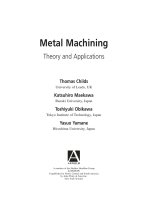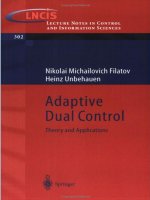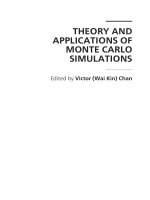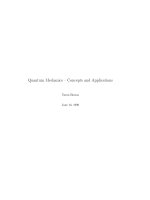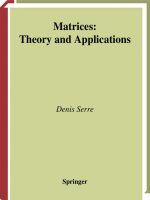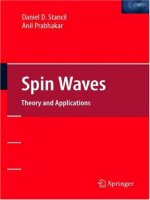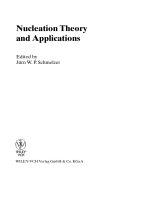- Trang chủ >>
- Khoa Học Tự Nhiên >>
- Vật lý
Quantum dots; theory and applications
Bạn đang xem bản rút gọn của tài liệu. Xem và tải ngay bản đầy đủ của tài liệu tại đây (5.12 MB, 184 trang )
Quantum Dots
Theory and Applications
Edited by Vasilios N. Stavrou
www.pdfgrip.com
Quantum Dots: Theory and Applications
Edited by Vasilios N. Stavrou
Published by AvE4EvA
Copyright © 2015
All chapters are Open Access distributed under the Creative Commons Attribution 3.0
license, which allows users to download, copy and build upon published articles even for
commercial purposes, as long as the author and publisher are properly credited, which
ensures maximum dissemination and a wider impact of our publications. After this work
has been published, authors have the right to republish it, in whole or part, in
any publication of which they are the author, and to make other personal use of the
work. Any republication, referencing or personal use of the work must explicitly identify
the original source.
As for readers, this license allows users to download, copy and build upon published
chapters even for commercial purposes, as long as the author and publisher are properly
credited, which ensures maximum dissemination and a wider impact of our publications.
Notice
Statements and opinions expressed in the chapters are these of the individual contributors
and not necessarily those of the editors or publisher. No responsibility is accepted for the
accuracy of information contained in the published chapters. The publisher assumes no
responsibility for any damage or injury to persons or property arising out of the use of any
materials, instructions, methods or ideas contained in the book.
Publishing Process Manager
Technical Editor
AvE4EvA MuViMix Records
Cover Designer
Published: 17 September, 2015
ISBN-10: 953-51-2155-3
ISBN-13: 978-953-51-2155-8
www.pdfgrip.com
www.pdfgrip.com
Contents
Preface
Chapter 1 Theory of Excitons and Excitonic Quasimolecules Formed
from Spatially Separated Electrons and Holes in Quasi-ZeroDimensional Nanostructures
by Sergey I. Pokutnyi and Włodzimierz Salejda
Chapter 2 Excitons and Trions in Semiconductor Quantum Dots
by S. A. Safwan and N. El–Meshed
Chapter 3 On the ’Three-Orders Time-Limit’ for Phase Decoherence in
Quantum Dots
by Witold Aleksander Jacak
Chapter 4 Charge States in Andreev Quantum Dots
by Ivan A. Sadovskyy, Gordey B. Lesovik and Valerii M. Vinokur
Chapter 5 Quantum Dots Prepared by Droplet Epitaxial Method
by Akos Nemcsics
Chapter 6 Physical Reasons of Emission Varying in CdSe/ZnS and
CdSeTe/ZnS Quantum Dots at Bioconjugation to Antibodies
by Tetyana V. Torchynska
www.pdfgrip.com
www.pdfgrip.com
Preface
The book Quantum Dots - Theory and Applications collects some
new research results in the area of fundamental excitations,
decoherence,
charge
states,
epitaxial
techniques
and
photoluminescence experiments related to devices made with
quantum dots.
This book is divided in two sections. First section includes the
fundamental theories on excitons, trions, phase decoherence, and
charge states, and the second section includes several applications
of quantum dots.
www.pdfgrip.com
www.pdfgrip.com
Chapter 1
Theory of Excitons and Excitonic Quasimolecules
Formed from Spatially Separated Electrons and Holes in
Quasi-Zero-Dimensional Nanostructures
Sergey I. Pokutnyi and Włodzimierz Salejda
Additional information is available at the end of the chapter
/>
Abstract
The theory of an exciton formed from a spatially separated electron and a hole is
developed within the framework of the modified effective mass method. The effect of
significantly increasing the exciton binding energy in quantum dots of zinc selenide,
synthesized in a borosilicate glass matrix and relative to that in a zinc selenide single
crystal is revealed. It is shown that the short-wavelength shift of the peak of the lowtemperature luminescence spectrum of samples containing zinc selenide quantum
dots, observed under experimental conditions, is caused by quantum confinement of
the ground-state energy of the exciton with a spatially separated electron and hole.
A review devoted to the theory of excitonic quasimolecules (biexcitons) (made up of
spatially separated electrons and holes) in a nanosystem that consists of ZnSe
quantum dots synthesized in a borosilicate glass matrix is developed within the
context of the modified effective mass approximation. It is shown that biexciton
(exciton quasimolecule) formation has a threshold character and is possible in a
nanosystem, where the spacing between quantum dots' surfaces is larger than a
certain critical arrangement. An analogy of the spectroscopy of the electronic states
of superatoms (or artificial atoms) and individual alkali metal atoms theoretically
predicted a new artificial atom that was similar to the new alkali metal atom.
Keywords: Excitons, exciton binding energy, quantum dots, excitonic quasimole‐
cules, spatially separated electrons and holes, superatoms
www.pdfgrip.com
4
Quantum Dots - Theory and Applications
1. Introduction
Quasi-zero-dimensional semiconductor nanosystems consisting of spherical semiconductor
nanocrystals, i.e., quantum dots with radii of a =1-10 nm and containing cadmium sulphide
and selenide, gallium arsenide, germanium, silicon, and zinc selenide in their volume, and
synthesized in a borosilicate glass matrix currently attract particular research attention due to
their unique photoluminescent properties, i.e., the ability to efficiently emit light in the visible
or near infrared ranges at room temperature [1-10]. The optical and electro-optical properties
of such quasi-zero dimensional nanosystems are to a large extent controlled by the energy
spectrum of the spatially confined electron-hole pair (exciton) [4-16].
In most theoretical models for calculating the energy spectra of quasiparticles in quantum dots
(QDs), the effective mass approximation is used, which was considered applicable for QDs by
analogy with bulk single crystals [11-13]. However, the problem concerning the applicability
of the effective mass approximation to the description of semiconductor QDs remains un‐
solved [4-18].
In [14], a new modified effective mass method is proposed to describe the exciton energy
spectrum in semiconductor QDs with radii of a ≈ aex (aex is the exciton Bohr radius in the
semiconductor material contained in the QD volume). It was shown that, within a model in
which the QD is represented as an infinitely deep potential well, the effective mass approxi‐
mation can be applied to the description of an exciton in QDs with radii a comparable to the
exciton Bohr radius aex, assuming that the reduced effective exciton mass is a function of the
radius a, μ = μ(a).
In the adiabatic approximation and within the modified effective mass method [14], an
expression for the binding energy of an exciton, whose electron and hole move within the
semiconductor QD volume, was derived in [15]. In [15], the effect of significantly increasing
the exciton binding energy in cadmium selenide and sulphide QDs with radii a, comparable
to the exciton Bohr radii aex and relative to the exciton- binding energy in cadmium selenide
and sulphide single crystals (by factors of 7.4 and 4.5, respectively) was also detected.
In the experimental study [7], it was found that excess electrons produced during interband
excitation of the cadmium sulphide QD had a finite probability of overcoming the potential
barrier and penetrating into the borosilicate glass matrix, into which the QD is immersed. In
experimental studies [10, 19] (as well as in [7]) using glass samples with cadmium-sulphide
and zinc selenide QDs, it was found that the electron can be localized in the polarization well
near the outer QD surface, while the hole moves within the QD volume.
In [10, 19], the optical properties of borosilicate glass samples containing QD zinc selenide
were experimentally studied. The average radii of such QDs were in the range a ≈ 2.0-4.8 nm.
In this case, the values of a are comparable to the exciton Bohr radius aex ≈ 3.7 nm in a ZnSe
single crystal. At low QD concentrations, when the optical properties of the samples are mainly
controlled by those of individual QDs in the borosilicate glass matrix, a shift of the peak of the
www.pdfgrip.com
Theory of Excitons and Excitonic Quasimolecules Formed from Spatially Separated Electrons and Holes in…
/>
low temperature luminescence spectrum to the short wavelength region (with respect to the
band gap Eg of the zinc selenide-single crystal) was observed. The authors of [10] assumed that
this shift was caused by quantum confinement of the energy spectra of the electron and the
hole localized near the spherical surface of the QD. In this case, the following problem
remained open: the quantum confinement of the state of which electron and hole (the hole
moving in the QD volume and the electron localized at the outer spherical QD-dielectric matrix
interface or the electron and hole localized in the QD volume) caused such a shift in the
luminescence spectrum peak?
The use of semiconductor nanosystems as the active region of nanolasers is prevented by the
low binding energy of the QD exciton [8, 9, 13]. Therefore, studies directed at the search for
nanostructures in which a significant increase in the binding energy of QD excitons can be
observed are of importance.
Currently, the theory of exciton states in quasi- zero- dimensional semiconductor nanosystems
has not been adequately studied. In particular, no theory exists for an exciton with a spatially
separated electron and hole in quasi- zero- dimensional nanosystems. Therefore, in this study,
we developed the theory of an exciton formed from a spatially separated electron and hole
(the hole is in the semiconductor QD volume and the electron is localized at the outer spherical
surface of the QD-dielectric matrix interface) [20-22]. It was shown that the short wavelength
shift of the peak of the low temperature luminescence spectrum of samples containing zinc
selenide QDs, observed under the experimental conditions of [10], was caused by quantum
confinement of the ground state energy of the exciton with a spatially separated electron and
hole. The effect of significantly increasing the binding energy of an exciton (with a spatially
separated electron and hole) in a nanosystem containing zinc selenide QDs, compared with
the binding energy of an exciton in a zinc selenide single crystal (by a factor of 4.1-72.6), was
detected [20-22].
In [10, 19], a shift of the spectral peak of the low temperature luminescence was also observed
for samples with a QD concentrations from x = 0.003-1%. It was noted [10, 19] that at such a
QD content in the samples, the interaction between charge carriers localized above the QD
surfaces must be taken into account. Therefore, in [23, 24], we develop the theory of excitonic
quasimolecules (biexcitons) (formed from spatially separated electrons and holes) in a
nanosystem, which consists of ZnSe QDs synthesized in a borosilicate glass matrix.
2. Spectroscopy of excitons in Quasi - Zero - Dimensional nanosystems
Let us consider the simple model of a quasi-zero-dimensional system, i.e., a neutral spherical
semiconductor QD of the radius a, which contains semiconductor material with the permit‐
tivity ε2 in its volume, surrounded by a dielectric matrix with permittivity ε1. A hole h with
the effective mass mh moves in the QD volume, while an electron e with the effective mass mе(1)
lies in the matrix (re and rh are the distances from the QD centre to the electron and hole). Let
www.pdfgrip.com
5
6
Quantum Dots - Theory and Applications
us assume that the QD valence band is parabolic. Let us also assume that there is an infinitely
high potential barrier at the spherical QD-dielectric matrix interface; therefore, the hole h
cannot leave the QD volume and the electron e cannot penetrate into the QD volume in the
model under study [20-22].
The characteristic dimensions of the problem are the quantities:
ah = ε2ℏ2 / mh e 2, aex = ε2ℏ2 / µ e 2, ae = ε1ℏ2 / me (1)e 2,
(1)
where ah and aex are the hole and exciton Bohr radii in the semiconductor with the
permittivity ε2, e is the elementary charge, μ= mе(2) mh /(mе(2)+ mh) is the reduced effective
mass of the exciton, mе(2) is the effective mass of an electron in the semiconductor with
permittivity ε2 and ae is the electron Bohr radius in the dielectric matrix with the permittiv‐
ity ε1. The fact that all characteristic dimensions of the problem are significantly larger than
the interatomic distances a0,
a , ae , ah , aex >> a0
allows us to consider the electron and hole motion in the quasi-zero-dimensional nanosystem
in the effective mass approximation [11-13].
We analysed the conditions of carrier localization in the vicinity of a spherical dielectric particle
of the radius a with the permittivity ε2 in [25-27]. In this instance, the problem of the field
induced by the carrier near a dielectric particle immersed in a dielectric medium with the
permittivity ε1 was solved in a final analytical form and analytical expressions for the potential
energy of the interaction of the carrier with the spherical interface of two media are presented.
Solving the Poisson equation with usual electrostatic boundary conditions
f (r¢, j | r , i )|r ¢= a = f ( r ¢, j )|
r Â= a
e1
,
ảf ( r Â, j )
ảf ( r ¢, j | r , i )
|r ¢= a = e 2 ảr  |r Â= a ,
ảr Â
(2)
the potential φ(r ' , j | r, i) | at the observation point r' in a medium with the permittivity εj,
induced by the charge e at the point r in a medium with the permittivity εi, can be presented
as a sum of the potentials induced by the image point charge e'(rij |r) at the point rij =(a/r)2rδij
+ r(1 – δij) and the linear distribution with the density ρij(y, r) of the image charge along a
straight line passing through the centre of the dielectric particle with the radius a and the charge
at the point r [25-27]:
www.pdfgrip.com
Theory of Excitons and Excitonic Quasimolecules Formed from Spatially Separated Electrons and Holes in…
/>
f ( r ¢, j | r , i ) =
¥
dy r ij ( y , r )
e¢( rij | r )
e
1
+
+ ị
e j | r ¢ - r | e j | r ¢ - rij | e j 0 | r ¢ - y( r / r )|
where
r11 = ( a 2 r 2 )r, e¢(r11 |r) = - b ( a r )e
(1-a )
2
r11 ( y , r ) = ba ( a ry)
a
2
( e a)q (( a r ) - y );
r22 = ( a 2 r 2 )r, e¢(r22 |r) = b ( a r )e
a
2
b
2
r 22 ( y , r ) = b (1 - a )( a ry) ( e a)q ( y - ( a r ));
r12 = r , e¢(r12 |r) = b e
(3)
c
a
r12 ( y , r ) = b (1 - a )(r y) ( e r )q ( y - r );
r21 = r , e¢ ( r12 | r ) = - b e
r 21 ( y , r ) = ba ( r y )
(1-a )
d
( e r )q ( r - y )
where θ(x) is the Heaviside unit-step function,
b=
( e 2 - e 1 ) ,a = e 1
(e 2 + e 1 )
(e 2 + e 1 )
(4)
Using expressions (3)-(3d), the energy U (re , rh , a) of the polarization interaction of the electron
and hole with the spherical QD-matrix interface at the relative permittivity ε = (ε2/ε1) ≫ 1 can
be presented as an algebraic sum of the energies of the interaction of the hole and electron with
self- V h h ′(rh , a), Vee'(re, a) and “foreign” Veh'(re, rh, a), Vhe'(re, rh, a) images, respectively [15, 16,
26-28]:
U (re ,rh , a , e ) = Vhh¢ ( rh , a , e ) + Vee ¢ ( re , a , e ) + Veh¢ ( re ,rh , a , e ) + Vhe ¢ ( re ,rh , a , e ) ,
(5)
where
Vhh ' ( rh , a , e ) =
ử
e 2 b ổ a2
+ e ữ,
ỗỗ 2
2
ữ
2e 2 a ố a - rh
ứ
(6)
e2b
a4
ì 2 2
,
2e 1a re (re - a 2 )
(7)
Vee ' ( re , a , e ) = -
Vhe ¢ ( re ,rh , a , e ) =
e2b
a2
×
,
2e 2 a r r - ( a r )2 r
e
h
e
e
www.pdfgrip.com
(8)
7
8
Quantum Dots - Theory and Applications
Veh¢ ( re ,rh , a , e ) = -
e2b
a2
×
.
2e 1a r r - ( a r )2 r
h e
h
h
(9)
In the studied simple model of a quasi-zero-dimensional nanostructure within the above
approximations and in the effective mass approximation using the triangular coordinate
system [14-16], re = |re|, rh = |rh|, r = |re – rh|, with the origin at the centre of the QD, the exciton
Hamiltonian (with a spatially separated hole moving within the QD volume and an electron
in the dielectric matrix) takes the following form [20-22, 29-32]:
h 2 ỉ ¶ 2 2 ¶ re2 - rh2 + r 2 ả 2 ử
+
ì
ỗ 2+ ì
ữ1
re r
ảre ảr ữứ
2 me( ) ỗố ảre re ảre
2 ả rh2 - re2 + r 2 ¶ 2 ư h 2 ổ ả 2 2 ả ử
h2 ổ ả 2
+
ì
+ ì ữ+
ỗỗ 2 + ì
ữỗ
rhr
2 mh ố ảrh rh ảrh
ảrhảr ứữ 2 m0 ốỗ ảr 2 r ảr ứữ
+ Veh ( r ) + U ( re ,rh , a , e ) + Ve ( re ) + Vh ( rh ) + Eg ,
H ( re ,rh ,r, a ) = -
(10)
where the first three terms are the operators of the electron, hole and exciton kinetic energy,
Eg is the band gap in the semiconductor with the permittivity ε2 and µ0 = me(1)mh / (me(1) + mh ) is
the reduced effective mass of the exciton (with a spatially separated hole and electron). In the
exciton Hamiltonian (10), the polarization interaction energy U(re, rh, a, ε) (5) is defined by
formulas (6)-(9) and the electron-hole Coulomb interaction energy Veh(r) is described by the
following formula:
1 ỉ 1 1 ư e2
Veh ( r ) = - ỗỗ + ữữ
2 ố e1 e 2 ứ r
(11)
In the exciton Hamiltonian (10), the potentials
ìï0, rh £ a
,
Vh ( rh ) = ớ
ùợ Ơ , rh > a
Ve ( re ) = ¥ , re £ a
(12)
describe the quasiparticle motion using the models of an infinitely deep potential well.
As the QD radius a increases (so that a ≫ aex0 ), the spherical interface of the two media (QD-
matrix) passes to the plane <semiconductor material with the permittivity>-matrix interface.
In this case, the exciton with the spatially separated electron and hole (the hole moves within
the semiconductor material and the electron lies in the borosilicate glass matrix) becomes twodimensional [20-22].
www.pdfgrip.com
Theory of Excitons and Excitonic Quasimolecules Formed from Spatially Separated Electrons and Holes in…
/>
The primary contribution to the potential energy of the Hamiltonian (10) describing exciton
motion in a nanosystem containing a large-radius QD, a ≫ aex0 , is made by the electron-hole
Coulomb interaction energy Veh(r) (11). The energy of the hole and electron interaction with
self- Vhh'(rh, a, ε) (6), Vee'(rh, a) (7) and “foreign” Veh'(re, rh, a) (9), Vhe'(re, rh, a) (8) images make a
significantly smaller contribution to the potential energy of the Hamiltonian (10). In the first
approximation, this contribution can be disregarded. In this case, only the electron-hole
Coulomb interaction energy (11) remains in the potential energy of the Hamiltonian (10)
[20-22]. The Schrodinger equation with such a Hamiltonian describes a two-dimensional
exciton with a spatially separated electron and hole (the electron moves within the matrix, and
the hole lies in the semiconductor material with the permittivity ε2), the energy spectrum of
which takes the following form [33, 34]:
0
Ryex
En = Ry
0
ex
,
(n + 1 / 2)
2
e 1 + e 2 ) ổ m0 ử
(
Ry
=
2
ỗ
ữ
4e 12e 22 ỗố m0 ữứ
(13)
0
where n = 0, 1, 2... is the principal quantum number of the exciton and Ry0 = 13.606 eV is the
Rydberg constant. The Bohr radius of such a two-dimensional exciton is described by the
following formula:
a0 ex =
2e 1e 2 h 2
e 1 + e 2 m0 e 2
,
(14)
and the binding energy of the ground state of such a two-dimensional exciton, according to
(13), is written as:
0
Eex0 = -4 Ryex
(15)
The binding energy (15) of the exciton ground state is understood as the energy required for
bound electron and hole state decay (in a state where n = 0).
To determine the ground-state energy of an exciton (with a spatially separated electron and
hole) in a nanosystem containing QDs of the radius a, we applied the variational method. When
choosing the variational exciton wave function, we used an approach similar to that developed
in [14]. Let us write the variational radial wave function of the exciton ground-state (1s electron
state and 1s hole state) in the nanosystem under study in the following form [20-22]:
www.pdfgrip.com
9
10
Quantum Dots - Theory and Applications
(
æ m ( a ) r ö a 2 - rh2
y 0 ( re , rh , r , a ) = Aexp ỗ
ữ
ỗ m a0 ÷ a 2
0
ex ø
è
(r
´
2
e
)
(16)
- a 2 r re - ( a / rh ) rh rh rh - ( a / re ) re re
a
a2
a2
a2
)
2
2
Here, the coefficient A is determined from the condition of normalization of the exciton wave
function (16):
¥
a
re + rh
a
0
r
ịredre ịrhdrh
ị y ( r , r , r , a ) rdr = 1
2
0
e
h
and the effectively reduced exciton mass μ(a) is the variational parameter.
As the QD radius a increases (so that a ≫ aex0 ), a two-dimensional exciton is formed in the
nanosystem. This leads to the variational exciton wave function (16) containing the WannierMott two-dimensional exciton wave eigenfunction [33, 34]. Furthermore, the polynomials from
re and rh enter the exciton variational function (16), which make it possible to eliminate
singularities in the functional E0(a,μ(a)) in the final analytical form.
To determine the exciton ground-state energy E0(a, ε) in the nanosystem under study using
the variational method, we wrote the average value of the exciton Hamiltonian (10) in wave
functions (16) as follows:
(
)
E0 a , m ( a ) = y 0 ( re , rh , r , a ) H ( re , rh , r , a ) y 0 ( re , rh , r , a ) =
re + rh
a
¥
ịdr ịdr ị dr r r r y ( r , r , r , a ) H ( r , r , r , a )y ( r , r , r , a )
a
e
0
h
r
e h
0
e
h
e
h
0
e
(17)
h
The dependence of the energy E0(a) of the exciton ground state (ne = 1, le = me =0; пh = 1, lh = тh=
0) (пе, lе, те and пh, lh, тh are the principal, orbital and magnetic quantum numbers of the electron
and hole, respectively) on the QD radius, a is calculated by minimizing the functional E0(a,
μ(a)) (17):
(
¶E0 a , m ( a )
¶m ( a )
)=F
( m ( a) , a)
(18)
Without writing cumbersome expressions for the first derivative of the functional ∂E0(a, μ(a))/
∂μ(a) =F(μ(a), a), we present the numerical solution to the equation F(μ(a), a) = 0 (18) in tabulated
www.pdfgrip.com
Theory of Excitons and Excitonic Quasimolecules Formed from Spatially Separated Electrons and Holes in…
/>
form. This follows from the table that the solution to this equation is the function μ(a), which
monotonically varies weakly within the limits [20-22]:
0.304 £ m ( a ) / m0 £ 0.359
(19)
as the QD radius a varies within the range
2.0 £ a £ 29.8 nm
(20)
(m0 is the electron mass in a vacuum). In this case, the reduced exciton effective mass μ(a) (19)
in the nanosystem differs slightly from the effective mass of an exciton (with a spatially
separated hole and electron) μ = 0.304m0 by the value (μ(a) – μ0)/μ0 ≤ 0.18 when the QD radii
vary within the range (20).
Simultaneously substituting the values of the variational parameter μ(a) (19) from Table 1 with
the corresponding QD radii from the range (20) into the functional E0(a, μ(a)) (17), we obtain
the exciton ground-state energy E0(a, ε) (17) as a function of the QD radius a [20-22].
a, nm
μ(a)/m0
2.0
0.359
3.0
0.352
4.0
0.345
5.0
0.338
6.0
0.331
8.0
0.325
10.0
0.319
15.0
0.313
20.0
0.308
29.8
0.304
Table 1. Variational parameter μ(a) as a function of the zinc selenide QD radius a.
The results of the variational calculation of the energy of the ground state of an exciton E0(a,
ε) (17) in the nanosystem under study containing zinc selenide QDs of the radius a (20) are
shown in the Figure 1 [20-22]. Here, the values of function μ(a) (19) and the results of the
variational calculation of the exciton ground-state energy E0(a, ε) (17) are obtained for a
nanosystem containing zinc selenide QDs, synthesized in a borosilicate glass matrix, as studied
in the experimental works [10, 19].
In the experimental work [10], borosilicate glass samples doped with zinc selenide with
concentrations ranging from x = 0.003-1%, obtained by the sol-gel method, were studied.
According to X-ray diffraction measurements, the average radii a of ZnSe QDs formed in the
www.pdfgrip.com
11
12
Quantum Dots - Theory and Applications
samples were within a ≈ 2.0-4.8 nm. In this case, the values of a˜ were comparable to the exciton
Bohr radius aex ≈ 3.7 nm in a zinc selenide single crystal. At low QD concentrations (x = 0.003
and 0.06%), their interaction can be disregarded. The optical properties of such nanosystems
are primarily controlled by the energy spectra of electrons and holes localized near the
spherical surface of individual QDs synthesized in the borosilicate glass matrix.
Figure
1.exciton
Dependences
the exciton(Eground
state-energy ( E0(a,ε) –Eg ) (17) (solid
Figure 1. Dependences
of the
groundof
state-energy
0(a,ε) –Eg) (17) (solid curve) and the binding energy of the
exciton ground
state
(E
(a,
ε)
–
E
)
(21)
(dashed
curve)
on
the
zinc
selenide
QDε)radius
in the
model of
an exciton
ex bindingg energy of the exciton ground state ( Eex(a,
curve) and the
– Eg )a(21)
(dashed
curve)
on with
a spatially separated electron and hole. The dash-dotted curve is the dependence of the exciton ground-state energy
the
zinc-selenide QD radius a in the model of an exciton with a spatially separated electron and
(E0(a, ε) – E
g) on the zinc selenide QD radius a in the exciton model, in which the electron and hole move within the
0
hole.
The
dash-dotted
is eV
theisdependence
of the
ground-state
energyE(E
ε) – EeV
zinc selenide
QD
volume
[16]. Egcurve
= 2.823
the band gap
in aexciton
zinc selenide
single crystal;
= 1.5296
g ) (15) and
ex0(a,
on(14)
the are,
zinc-selenide
QDthe
radius
a inenergy
the exciton
which
and hole
move
respectively,
binding
of themodel,
groundinstate
andthe
theelectron
Bohr radius
of a two-dimensional
aex0 , = 0.573 nm
exciton with
a spatially
separated electron
and hole.
within
the zinc-selenide
QD volume
[16]. Eg = 2.823 eV is the band gap in a zinc-selenide single
crystal; ܧ = 1.5296 eV (15) and ܽ , = 0.573 nm (14) are, respectively, the binding energy of
௫
௫
In [10, 19], a peak
in the low-temperature
luminescence spectrum at an energy of E1 ≈ 2.66 eV
the ground state and the Bohr radius of a two-dimensional exciton with a spatially separated
was observed
at the temperature T = 4.5 K in samples with x = 0.06%; this energy is lower than
electron
hole.
the band gap of a zinc selenide single crystal
(Eand
g = 2.823 eV). The shift of the peak of the lowtemperature luminescence spectrum with respect to the band gap of the ZnSe single crystal to
the short-wavelength region is ΔE1 = (E1–Eg) ≈ –165 meV. The authors of [10] assumed that the
shift ΔE1 was caused by quantum confinement of the energy spectra of electrons and holes
localized near the spherical surface of individual QDs, and that it was associated with a
decrease in the average radii a of zinc-selenide QDs at low concentrations (x = 0.06%). In this
case, the problem of the quantum confinement of which electron and hole states (the hole
www.pdfgrip.com
Theory of Excitons and Excitonic Quasimolecules Formed from Spatially Separated Electrons and Holes in…
/>
moving within the QD volume and the electron localized at the outer spherical QD-dielectric
matrix interface or the electron and hole localized in the QD volume) caused such a shift of the
luminescence-spectrum peak remained open.
Comparing the exciton ground-state energy (E0(a,ε) – Eg) (17) with the energy of the shift in
the luminescence-spectrum peak ΔE1 ≈ –165 meV, we obtained the average zinc selenide QD
radius a1 ≈ 4.22 nm (see Figure 1) [20-22]. The QD radius a1 may be slightly overestimated,
since the variational calculation of the exciton ground-state energy can yield slightly overes‐
timated energies [33, 34]. The determined average QD radius a1 was found to be within the
range of the average radii of zinc selenide QDs (a ≈ 2.0-4.8 nm) studied under the experimental
conditions of [10, 19].
¯
It should be noted that the average Coulomb interaction energy V
eh
(a, ε) =
ψ0(re , rh , r, a) | V eh (r) | ψ0(re , rh , r, a) between the electron and hole primarily contributed to the
ground-state energy (17) of the exciton in the nanosystem containing zinc selenide QDs with
radii a1 comparable to the exciton Bohr radius in a zinc-selenide single crystal (aex ≈ 3.7 nm).
In this case, the average energy of the interaction of the electron and hole with self- and
“foreign” images,
(
Vee ¢ ( a , e ) + Vhh¢ ( a , e ) + Veh¢ ( a , e ) + Vhe ¢ ( a , e )
)=
= áy o ( re , rh , r , a )| Vee ¢ ( re , a , e ) + Vhh ' ( rh , a , e ) + Veh¢ ( re , rh , a , e ) + Vhe ¢ ( re , rh , a , e )|y o ( re , rh , r , a )ñ
yielded a significantly smaller contribution to the exciton ground-state energy (17),
0.04 £ ëéVee ' ( a , e ) + Vhh' ( a , e ) + Veh' ( a , e ) + Vhe ' ( a , e ) ùû / E0 ( a , e ) £ 0.12 éë 20 - 22 ùû .
Thus, the short-wavelength shift ΔE1 of the low temperature luminescence spectrum peak is
caused by renormalization of the electron-hole Coulomb interaction energy Veh(r) (11), as well
as renormalization of the energy U(re, rh, r, a, ε) (5) of the polarization interaction of the electron
and hole with the spherical QD-dielectric matrix interface, which is associated with spatial
confinement of the quantization region by the QD volume. In this case, the hole moves within
the QD volume and the electron is localized at the outer spherical QD-dielectric matrix
interface.
The binding energy of the ground state of an exciton (with a spatially separated electron and
hole) Eex(a, ε) in a nanosystem containing zinc selenide QDs of the radius a is the solution to
the radial Schrodinger equation with a Hamiltonian containing, in contrast to Hamiltonian
(10), only the terms Vhe'(re,rh, a, ε) (8) and Veh'(re, rh, a, ε) (9) in the polarization interaction energy
U(re, rh, a, ε) (5), which describe the energies of the hole and electron interaction with “foreign”
images, respectively [15, 27, 28]. Therefore, the exciton ground-state binding energy Eex(a, ε)
is defined by the expression [20-22]:
www.pdfgrip.com
13
14
Quantum Dots - Theory and Applications
(
)
Eex ( a , e ) = E0 ( a , e ) - y o ( re , rh , r , a ) Vhh¢ ( rh , a , e ) + Vee ¢ ( re , a , e ) y o ( re , rh , r , a ) ,
where the term
ψo (re , rh , r, a) |(V h h ′(rh , a, ε ) + V ee ′(re , a, ε ))| ψo (re , rh , r, a)
(21)
describes the
average energy of hole and electron interaction with self-images.
Since the average energies of the interaction of the hole with its image and the average energies
of the interaction of the electron with its image deliver contributions that take opposing signs
to expression (21), they significantly compensate for each other. Therefore, the binding
energies of the exciton ground state Eex(a, ε) (21) slightly differs from the corresponding total
energies of the exciton ground state E0(a, ε) (17). This difference,
D=
(
Eex ( a , e ) - E0 ( a , e )
) / Eex ( a,e ) ,
varies within Δ ≤ 4%, as QD radii a varies within the range 3.84 ≤ a ≤ 8.2 nm (see Figure 1) [20-22].
Figure 1 shows the dependences of the total energy E0(a, ε) (17) and the binding energy Eex(a,
ε) (21) of the ground state of the exciton with a spatially separated electron and hole on the
QD size for a nanosystem containing zinc selenide QDs of the radius a. We can see that the
bound states of electron-hole pairs arise near the spherical surface of the QD, starting from the
QD critical radius a ≥ ac(1) ≈ 3.84 nm. In this case, the hole is localized near the QD inner surface
and the electron is localized at the outer spherical QD-dielectric matrix interface. Starting from
the QD radius a ≥ ac(1), the electron-hole pair states are in the region of negative energies
(counted from the top of the band gap Eg for a zinc selenide single crystal), which corresponds
to the electron-hole bound state [20-22, 29-23]. In this case, the electron-hole Coulomb inter‐
action energy Veh(r) (11) and the energy U(re, rh, r, a, ε) (5) of the polarization interaction of the
electron and hole with the spherical QD-dielectric matrix interface dominate the energy of the
quantum confinement of the electron and hole in the nanosystem under study.
The total energy |E0(a, ε)| (17) and the binding energy |Eex(a, ε)| (21) of the ground state of
the exciton with a spatially separated electron and hole increases with QD radius a. In the range
of radii
4.0 £ a £ 2.8 nm
(22)
the binding energy |Eex(a, ε)| (21) of the exciton ground state significantly (by a factor of
¯
4.1-76.2) exceeds the exciton binding energy in a zinc selenide single crystal, Eex0 ≈ –21.07 meV.
Starting from the QD radius a ≥ ac(2)≈ 29.8 nm, the total energies (17) and binding energies (21)
of the exciton ground state asymptotically tend to the value Eex0 = –1.5296 eV, which charac‐
terizes the binding energy of the ground state of a two-dimensional exciton with a spatially
separated electron and hole (see the figure 1) [20-22, 29-32].
www.pdfgrip.com
Theory of Excitons and Excitonic Quasimolecules Formed from Spatially Separated Electrons and Holes in…
/>
The obtained values of the total energy E0(a, ε) (17) of the exciton ground state in the nano‐
system satisfy the inequality
( E ( a,e )
)
- Eg = DV ( a)
0
(23)
where ΔV(a) is the potential-well depth for the QD electron. For a large class of II-VI semicon‐
ductors in the region of QD sizes, a ≥ aex0 , ΔV(a) = 2.3-2.5 eV [7]. Satisfaction of condition (23)
likely makes it possible to disregard the effect of the complex structure of the QD valence band
on the total energy (17) and the binding energy (21) of the exciton ground state in the nano‐
system under study when deriving these quantities.
The effect of a significant increase in the binding energy |Eex(a, ε)| (21) of the exciton ground
state in the nanosystem under study, according to formulas (5) to (9), (11), (13) to (15), (17) and
(21) is controlled by two factors [20-22, 29-32]: (i) a significant increase in the energy of the
electron-hole Coulomb interaction |Veh(r)| (11) and an increase in the energy of the interaction
of the electron and hole with “foreign” images |Veh'(re, rh, r, a, ε)| (9), |Vhe'(re, rh, r, a, ε)| (8) (the
“dielectric enhancement” effect [34]); (ii) spatial confinement of the quantization region by the
QD volume. In this case, as the QD radius a increases, starting from a ≥ ac(2) ≈ 52 aex0 ≈ 29.8 nm,
the exciton becomes two-dimensional, with a ground-state energy of Eex0 (15), which exceeds
the exciton binding energy Eex in the zinc selenide single crystal by almost two orders of
magnitude:
(E
0
ex
)
/ Eex0 » 72.6 .
The “dielectric enhancement” effect is caused by the following factor. When the matrix
permittivity ε1 is significantly smaller than the QD permittivity ε2, the most important role in
the electron-hole interaction in the nanosystem under study is fulfilled by the field induced by
these quasiparticles in the matrix. In this case, electron-hole interaction in the nanosystem
appears to be significantly stronger than in an infinite semiconductor with the permittivity ε2
[34].
In [16], in the nanosystem experimentally studied in [10], an exciton model in which the
electron and hole move within the zinc selenide QD volume was studied. Using the variational
method, within the modified effective mass method, the dependence of the exciton groundstate energy E0(a, ε) on the QD radius a in the range (20) was obtained in [16] (see Figure 1). It
¯
was shown that, as the QD radius increased, starting from a ≥ ac = 3.90 aex0 = 1.45 nm, a bulk
exciton appeared in the QD; its binding energy,
www.pdfgrip.com
15
16
Quantum Dots - Theory and Applications
Eex0 = -
h2
( )
0
2 m aex
2
(24)
¯
was 21.07 meV (μ = 0.132m0 and aex0 = 3.7 nm are the reduced effective mass and Bohr radius of
the exciton in the zinc-selenide forming the QD volume). The bulk exciton in the QD is
understood as an exciton whose structure (reduced mass, Bohr radius and binding energy) in
the QD does not differ from the structure of an exciton in an infinite semiconductor material.
As the QD radius a increases (a ≥ ac), the exciton ground-state energy E0(a) asymptotically
follows the binding energy of the bulk exciton (24) (see Figure 1) [20-22, 29-32].
Thus, using the exciton model, in which an electron and hole move in the QD volume, it is
impossible to interpret the mechanism of the appearance of the nanosystem luminescencespectrum peak with the shift ΔE1 ≈ –165 meV, obtained in [10, 19].
A comparison of the dependences of the exciton ground-state energy E0(a) in the nanosystem
[10], obtained using two-exciton models (see Figure 1) (the electron and hole move within the
zinc selenide QD volume [16]) (model I); the hole moves within the zinc selenide QD volume
and the electron is localized in the boron silicate glass matrix near the QD spherical surface
(model II), allowing for the following conclusion. In model I, as the QD radius a increases,
starting from a ≥ ac ≈ 14.5 nm, the exciton ground- state energy E0(a) asymptotically follows the
¯
binding energy of the bulk exciton Eex0 ≈ –21.07 meV (24). In model II, as the QD radius increases,
starting from a ≥
Eex0
ac(2) ≈ 29.8 nm, the exciton ground-state energy (17) asymptotically follows
= –1.5296 eV (15) (characterizing the binding energy of the ground state of a two- dimen‐
sional exciton with a spatially separated electron and hole), which is significantly lower than
¯
Eex0 ≈ –21.07 meV [20-22, 29-32].
3. Excitonic quasimolecules formed from spatially separated electrons and
holes
We considered a model nanosystem [23, 24] that consisted of two spherical semiconductor
QDs, A and B, synthesized in a borosilicate glass matrix with the permittivity ε1. Let the QD
radii be a and the spacing between the spherical QD surfaces be D. Each QD is formed from a
semiconductor material with the permittivity ε2. For simplicity, without loss of generality, we
assumed that holes h (A) and h (B) with the effective masses mh were in the QD (A) and QD (B)
centres and the electrons е(1) and е(2) with the effective masses me(1) were localized near the
spherical QD(A) and QD (B) surfaces, respectively. The above assumption was reasonable,
since the ratio between the effective masses of the electron and hole in the nanosystem was
much smaller that unity: ((me(1) / mh ) ≪ 1). Let us assume that there was an infinitely high
potential barrier at the spherical QD-matrix interface. Therefore, in the nanosystem, holes did
not leave the QD bulk and electrons did not penetrate into the QDs.
www.pdfgrip.com
Theory of Excitons and Excitonic Quasimolecules Formed from Spatially Separated Electrons and Holes in…
/>
In the context of the adiabatic approximation and effective mass approximation, using the
˜ , a˜) of
˜ , a˜ ) and the binding energy E (D
variational method, we obtained the total energy E0(D
e
the biexciton singlet ground state (the spinning of the electrons е(1) and е(2) were antiparallel)
in such a system as functions of the spacing between the QD surfaces D and the QD radius a
[23, 24]:
ỉ % ư
ỉ % ử
ổ ử
E0 ỗ D
, a% ữ = 2 Eex
a% + E ỗ D
, a% ữ ,
õ ỗ ữ
ố ứ
ố
ứ
ố
ứ
(25)
Here, the binding energy Eex (a˜ ) (17) of the ground state of the exciton (formed from an elec‐
tron and a hole spatially separated from the electron) localized above the QD(A) (or QD(B))
surface was determined in [23, 24] (by the parameters a˜ = (a / aex0 ) (aex0 = 3.7 nm and the exciton
˜ = ( D / a 0 )). For the nanosystem under study, the values
Bohr radius in a single crystal ZnSe, D
ex
)
(
˜
of the binding energies Eex a were calculated in [23, 24] for use in the experimental condi‐
tions of [10, 19].
˜ , a˜ )
The results of the variational calculation of the binding energy Eв (D
of the biexciton
singlet ground state in the nanosystem of ZnSe and QDs with an average radii of
a¯ 1 = 3.88 nm,, synthesized in a borosilicate glass matrix, are shown in [23, 24]. Such a nanosys‐
tem was experimentally studied in [10, 19]. In [10, 19], the borosilicate glassy samples doped
with ZnSe to the content x from x = 0.003-1% were produced using the sol-gel technique. At a
QD content of x = 0.06 %, one must take into account the interaction of charge carriers localized
above the QD surfaces.
˜ , a˜ ) of the biexciton singlet ground state in the nanosystem of ZnSe
The binding energy Eв (D
QDs with average radii of a¯ 1 = 3.88 nm has a minimum of Eв(1)(D1, a¯ 1) ≈ − 4, 2 meV (at the
spacing D1 ≅ 3.2 nm) [23, 24]. The value of
( )
Eв 1 corresponds to the temperature T c ≈ 49 K . In
[23, 24], it follows that a biexciton (excitonic quasimolecule) is formed in the nanosystem,
starting from a spacing between the QD surfaces of D ≥ Dc(1) ≅ 2, 4 nm. The formation of such
a excitonic quasimolecule (biexciton) is of the threshold character and possible only in a
nanosystem with QDs with average radii a¯ 1 , such that the spacing between the QD surfaces
D exceeds a certain critical spacing Dc(1). Moreover, the exciton quasimolecule (biexciton) can
exist only at temperatures below a certain critical temperature, i.e., T с ≈ 49 K [23, 24].
As follows from the results of variational calculation [23, 24], the binding energy of an exciton
(formed from an electron and a hole spatially separated from the electron) localized above the
surface of the QD(A) (or a QD(B)) with an average radius of a¯ 1 = 3, 88 nm is
˜ , a˜ ) (25)
Eex (a¯ 1) ≅ − 54 meV . In this case, the energy of the biexciton singlet ground state E0(D
˜
takes the value E (D , a˜ ) = -112meV.
0
From the results of variational calculation [23, 24], of the biexciton (exciton quasimolecule)
˜ , a˜), it follows that the major contribution to the binding energy (25) is
binding energy Ee (D
www.pdfgrip.com
17
18
Quantum Dots - Theory and Applications
made by the average energy of the exchange interaction of the electrons е(1) and е(2) alongside
holes h (A) and h (B). At the same time, the energy of the Coulomb interaction makes a much
˜ , a˜) (25).
smaller contribution of the biexciton binding energy Ee (D
The major contribution to the exchange is interaction energy, created by the energy of the
exchange interaction of the electron е(1) with the holes h (B), as well as of the electron е(2) with
the holes h (B), and of the electron е(2) with the holes h (A). The major contribution to the
Coulomb is interaction energy, created by the energy of the Coulomb interaction of the electron
е(1) with the holes h (B), as well as of the electron е(2) with the holes h (A) [23, 24].
As the spacing D between the QD(A) and QD(B) surfaces is increased, starting from
D ≥ Dc(2) ≅ 16, 4 nm, the average Coulomb interaction energy substantially decreases. In
addition, because of the decrease in the overlapping of the electron wave function, the average
exchange interaction energy also substantially decreases. Consequently, the average Coulomb
interaction energy and the average energy of the exchange interaction of the electrons е(1) and
е(2) with the holes h (A) and h (B) sharply decrease in comparison with the exciton binding
energy Eex (a˜ ) (17) [23, 24], resulting in decomposition of the biexciton in the nanosystem into
two excitons (formed of spatially separated electrons and holes) localized above the QD(A)
and QD(B) surfaces.
4. Theory of new superatoms — Analogue atoms from the group of alkali
metals
The idea of superatoms (or artificial atoms) is essential for the development of mesoscopic
physics and chemistry [20-22, 29, 30]. Superatoms are nanosized quasi-atomic nanostructures
formed from spatially separated electrons and holes (the hole in the volume of the QD and the
electron is localized on the outer spherical quantum dot matrix dielectric interface) [20-22, 29,
30]. This terminology can be accepted as correct, given the similarities between the spectra of
discrete electronic states of atoms and superatomic atoms, and the similarities in terms of their
chemical activities [20-22, 29, 30].
In [20-22], within the framework of the modified effective mass method [14], the theory of
artificial atoms formed from spatially separated electrons and holes (holes moving in the
volume of a semiconductor (dielectric) QD and an electron localized on the outer spherical
interface between the QD and a dielectric matrix) is developed. The energy spectrum of
superatoms (excitons of spatially separated electrons and holes) from QD radius a ≥ ac (about
4 nm) is fully discrete [20-22, 29, 30]. This is referred to as a hydrogen-superatom and is
localized on the surface of a valence electron QD. The energy spectrum of the superatom
consists of a quantum-dimension of discrete energy levels in the band gap of the dielectric
matrix. Electrons in superatoms are localized in the vicinity of the nucleus (QD). The electrons
move in well-defined atomic orbitals and serve as the nucleus of QD, containing in its volume
semiconductors and insulators. Ionization energy superatoms take on large values (of the
www.pdfgrip.com
Theory of Excitons and Excitonic Quasimolecules Formed from Spatially Separated Electrons and Holes in…
/>
order of 2.5 eV), which is almost three orders of magnitude higher than the binding energy of
the excitons in semiconductors [20-22, 29, 30].
We will briefly discuss the possible physical and chemical effects that are relevant for the
results of this paper. In our proposed [20-22, 29, 30] model of a hydrogen superatom localized
on the surface of the QD is a valence electron. In quasi-atomic structures of the outer valence,
electrons can participate in a variety of physical and chemical processes, similar to the atomic
valence electrons in atomic structures. Artificial atoms have the ability to connect to the
electron orbitals of electrons N (where N can vary from one to several tens). At the same time,
the number of electrons N can take values of the order of a few tens or even surpass the serial
numbers of all the known elements found in Mendeleev's table [20-22, 29, 30]. This new effect
allows for attaching to the electronic orbitals of artificial atoms N electrons, causing a high
reactivity and opening up new possibilities for superatoms related to their strong oxidizing
properties, increasing the possibility of substantial intensity in photochemical reactions during
catalysis and adsorption, as well as their ability to form many new compounds with unique
properties (in particular, the quasi-molecule and quasicrystals) [24, 29, 30]. Therefore, studies
aimed at the theoretical prediction of the possible existence of artificial new atoms (not listed
in the Mendeleev table) and to their study in terms of experimental conditions are very
relevant.
Quantum discrete states of the individual atoms of alkali metals are determined by the
movement of only one, i.e., the outermost valence electron, around a symmetric atomic core
(containing the nucleus and the remaining electrons) [35]. In the hydrogen superatom formed
quantum-energy spectra of discrete energy levels of the valence electron [20-22, 29, 30]. Thus,
the observed similarity of the spectra of discrete electronic states and individual superatoms
alkali metal atoms, as well as the similarity of their chemical activity [20-22, 29, 30, 35].
In Section 4, on the basis of a spectroscopic analogy of electronic states of artificial atoms and
individual alkali metal atoms, a new artificial atom is theoretically predicted, which is similar
to the new alkali metal atom.
In [20-22, 29, 30], a new model of an superatom is proposed, which is a quasi-zero-dimensional
nanosystem consisting of a spherical QD (nucleus superatom) with radius a and which is
included within its scope as a semiconductor (dielectric) with a dielectric constant ε2, sur‐
rounded by a dielectric matrix with a dielectric constant ε1. A hole h with the effective mass
mh moves in the QD volume, while an electron e with the effective mass mе(1) lies in the dielectric
matrix. In such a nanostructure, the lowest electronic level is situated in the matrix and the
humble hole level is the volume QD. Large shift of the valence band (about 700 meV) is the
localization of holes in the volume QD. A large shift of the conduction band (about 400 meV)
is a potential barrier for electrons (electrons move in the matrix and do not penetrate into the
volume QD). The Coulomb interaction energy of an electron and a hole, and the energy of the
electron polarization interaction with the surface section (QD-matrix) (since the permittivity
ε2 is far superior to QD permittivity ε1 matrix) cause localization of the electron in the potential
well above the surface of QD [20-22, 29, 30].
www.pdfgrip.com
19
